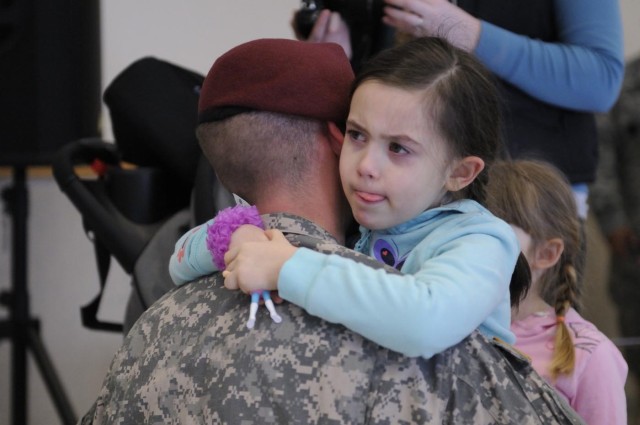FORT RICHARDSON, Alaska - The paratroopers of 23rd Engineer Company (Airborne), 6th Engineer Battalion, 3rd Maneuver Enhancement Brigade, marked their impending 12-month deployment to Afghanistan during a brief Feb. 19 ceremony at the Lee Reserve Center.
Families, friends and fellow Soldiers packed the LRC auditorium to witness the casing of the unit's guidon, signifying their release from U.S. Army Alaska pursuant to their eventual integration into International Security Assistance Force-Afghanistan.
"Today is a significant day for the Guardians as well as for all Sappers of the 6th Engineer Battalion as we once again send a portion of our formation into harm's way to protect and defend our precious freedoms," said ceremony presiding officer and 6th Eng. Battalion commander, Lt. Col. Roosevelt Samuel.
Samuel said the unit traced a unique path, activating 18 months ago as an airborne combat engineer company with the challenge of rapidly building combat power through personnel, equipment and training for an unknown but inevitable deployment.
"The Army started them off as they do most units: with lots of junior Soldiers and very few leaders," Samuel recalled. "So they started out focusing on the basics and slowly worked toward building their combat engineer and their airborne skills as their leaders slowly crept in.
"Then, just as they began to master these two skills, the Army decided that they were going to deploy not as a combat engineer company, but as a route clearance company," Samuel explained. "This disciplined group of Soldiers who have embraced the Army's call for all Soldiers to be flexible, adaptive and agile as well as the Engineer Regiment's call to be able to execute full-spectrum engineer operations, they answered that call and began training on their new skillset."
Samuel said the company trained at the Engineer's home station of Fort Leonard Wood, Mo., in the use of heavy armored route clearance vehicles such as engineer enhanced Buffalo, Husky and RG-31 mine resistant ambush protected vehicles, before deploying to the National Training Center, Fort Irwin, Calif., for the unit's month-long mission readiness exercise.
"The biggest turnaround is the type of equipment that they use," Samuel said of the company's transition. "This is an airborne Sapper company, very light and specializing in demolitions and explosives. Now, they're getting fielded with these huge up-armored vehicles that protect them from the catastrophic blast of an (improvised explosive device), so they had to learn how to operate this highly technical, very heavy, almost cumbersome piece of equipment."
Army Capt. Ryan Hintz, 23rd Eng. commander, said an airborne combat engineer company traditionally provides mobility, countermobility and survivability engineer support to forced-entry airborne maneuver forces. Although the company will be using new equipment, he said they are not breaking from their core capabilities.
"We're not talking about going from apples to oranges," Hintz elaborated. "Route clearance is mobility.
"What we're using are new techniques and new pieces of equipment to make us more effective against the enemy threat," he continued. "As an engineer, mobility has always been something that we do. Route clearance is an extension of that and it has developed out of what the enemy is doing to counter our efforts."
Hintz said the company has also focused on family readiness in anticipation of grappling with the unique challenges of weathering a deployment outside of the continental U.S.
"Being in Alaska is a unique situation for any deployed family because we're in the United States but we're very geographically distant from where most families come from," Hintz said. "So we have all of the comfort items, all of the familiar things that exist in the Lower 48, only we're a couple thousand miles away from our families."
Although entering the young military couple's second deployment, Ashley Hintz, the commander's wife and company co-family readiness group leader, said she expects new challenges now she has the responsibility of raising the couple's 14-month-old son, Liam, alone.
"It's not just me I have to worry about," she said. "I have to take care of him and make sure he doesn't forget daddy.
"I was an FRG leader during our last deployment and I didn't have a child so I didn't really know what parents were going through," Ashley Hintz recalled. "Now I can definitely understand the other responsibilities, other things they have on their plate so it gives me a little bit more insight into what they're going through. I'm going through it myself."
Ashley Hintz said she plans to cope with her husband's absence through stability and an active lifestyle.
"We get into our own routine of what mommy and baby do," she said. "We see a lot of friends, we stay busy, we go out every day and we don't stay at home much."
Although she said she is sad to see her husband go, Ashley Hintz supports his contribution to Operations Enduring Freedom.
"I'm proud of him," she said. "This is his job, company command, that's what he's always wanted to do. He always wanted an airborne Sapper company and that's what he got.
"He's super excited and to see him excited makes it a lot easier to send him off knowing he's excited and he knows his guys are ready and they're going to do what they were trained to do."




Social Sharing